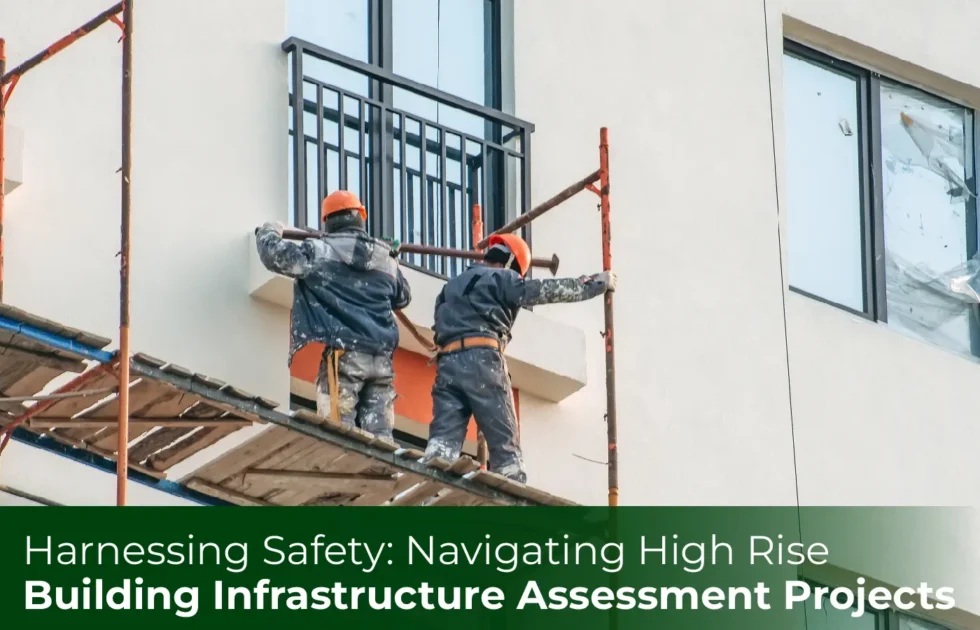Introduction:
Infrastructure Assessment, repainting, waterproofing, or any civil work on high-rise buildings entails substantial safety hazards, demonstrating the critical need for strict safety procedures.
Often established during company-provided training, these guidelines protect people (employees, residents, visitors, and more) and property. Property owners or managers also discuss safety with potential Infrastructure Assessment companies and commercial painters before commissioning their services. Ensuring these professionals are committed to following all safety protocols in detail is fundamental to the project’s success and safety.
This blog will detail the safety measures to be taken while working on high-rise buildings.
What’s the definition of a high-rise building?
A high-rise building has multiple floors, typically 12 stories or more. The height that qualifies a building as a high-rise can vary depending on the context and location. Yet, a building that rises above the surrounding buildings and significantly impacts the city’s skyline is considered a high-rise.
Due to their height and complexity, high-rise buildings often require specialized construction techniques and safety measures. They can be residential complexes, commercial complexes, large hotels, or hospitals.
Following are the safety steps to safeguard people and property while working on Infrastructure Assessment or repainting projects:
Safety First:
Before beginning any project, we ensure safety by thoroughly examining ladders, scaffolding, and ropes at high-rise buildings. This critical inspection ensures that all equipment is in top shape to avoid mishaps. If the inspection reveals any wear and tear or damage, the old equipment is replaced with new, dependable alternatives. This practice demonstrates a dedication to the safety of people and property and efficiency on the job.
Inspecting the equipment:
Before commencing any commercial repainting project, professional painters inspect all tools and equipment, focusing on electricity-powered ones. This proactive approach ensures that any potential malfunction leading to hazards is identified and addressed. To bolster safety measures, painters often enlist the expertise of electricians to conduct thorough inspections of electrical tools at high-rise buildings. Careful preparation prevents accidents, delivering a safe, efficient, high-quality repainting service.
Wearing protective gear:
Wearing protective gear minimizes the harm of exposure to potentially harmful chemicals. The materials used in manufacturing the protective gear protect against chemical exposure and other job risks. The protective ensemble includes gloves, pants, and headgear to protect distinct body parts. Among the many protective gear alternatives, Zahabi will choose the best.
Wearing Respiratory Protective masks:
When preparing walls for repainting, we prioritise safety and cleanliness by wearing high-quality dust masks to protect from harmful substances. This essential gear shields our team from the toxic dust particles generated during the sanding and scrubbing. In scenarios requiring the utmost safety, we may also use special masks, known for their exceptional dust resistance, guaranteeing a secure and efficient painting environment.
Keeping first-aid kids handy:
Keeping first aid kits on hand while repainting high-rise buildings is more than a precaution; it is a need. Even minor cuts and accidents, typical in the fast-paced Infrastructure Assessment industry, can be treated quickly and successfully with the basic supplies available in a first aid kit. Professionals in the field recognize the need for these kits. This emphasis on safety demonstrates the professionalism and care that go into every Infrastructure Upkeep project.
Employing Eco-Friendly Solutions:
We at Zahabi use only chemical-free, eco-friendly paints because we care for our people. This critical aspect decreases health risks, making our workers and customers safer. Lead-free and non-toxic paints are becoming more popular as people seek high-quality, healthy products. Our professional workforce sets environmental and health safety standards by using eco-friendly products.
Performing a Preliminary Building Inspection:
A comprehensive inspection is critical to ensure the safety of our operations in high-rise buildings. During the inspection, professionals thoroughly check the building for any faults or loose components that could represent a risk, potentially resulting in injuries during the project. If they find any such areas of concern, they swiftly advise that repairs be performed before the repainting or waterproofing project starts. This proactive approach protects the workforce and secures the success of the project.
Inspecting open wires for safety:
A vital step during building inspections is to look for open electrical lines, which can be a source of electrical risks. These loose wires, which carry electricity, pose a high risk to anyone around. Identifying and mitigating potential hazards creates a safer environment for the workforce and residents.
Conclusion:
It is vital to recognise that safety measures for high-rise Infrastructure Assessment projects are interconnected and can be applied collectively for maximum effectiveness. Our priority is to conduct a comprehensive risk assessment to ensure a secure workplace for everyone. This crucial step forms the foundation of a detailed safety strategy that effectively identifies and reduces hazards, prioritizing worker protection.
Get in touch with us.

